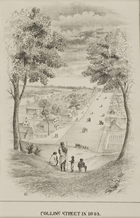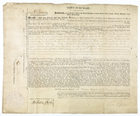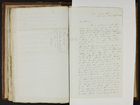Multimedia Content

Collins Street East from the Independent Chapel, c. 1841 - c. 1845, by Jones, Henry Gilbert (Etcher, c. 1804‑1888), courtesy of The State Library of Victoria.
Details
Collins Street from the West, c. 1841 - c. 1845, by Jones, Henry Gilbert (Etcher, c. 1804‑1888), courtesy of The State Library of Victoria.
Details
Collins Street in 1843, by Unknown (F.H.), courtesy of The Ian Potter Museum of Art; The University of Melbourne Art Collection. Gift of the Russell and Mab Grimwade Bequest 1973.
Details
Grant by Purchase to Thomas Hood, 1839, courtesy of University of Melbourne Archives; Hood, Thomas.
Details
Letter to Public Works Committee from M Howe Town Surveyor , 29 March 1844, courtesy of Public Record Office Victoria, Victorian Archives Centre.
Details
Collins Street
Melbourne's best-known and most fashionable street, Collins Street, also contains much of the city's most interesting commercial architecture. Part of the Melbourne grid plan drawn up by Robert Hoddle in 1837, it was named after Lieutenant-Governor David Collins who had led the unsuccessful 1803 Sorrento settlement.
Building began before 1837, but the first blocks were not sold until 1 June 1837. The government kept the block between Market and William streets for the Western Market, established 1841, and the Melbourne Town Hall block on the Swanston Street corner. Most activity in the 1830s was to the west of Elizabeth Street where many of Melbourne's merchants had their offices. Some of the first shops established in Collins Street were draperies, haberdasheries and ironmongers. Haberdasher Michael Cashmore arrived in 1840 with wares including 'Hosiery, Drapery, Haberdashery, also every variety of ready made clothing, Hats, Bonnets, Boots and Shoes'. His store on the corner of Elizabeth and Collins streets was rented from Alexander Brunton, and was known variously as Brunton's or Cashmore's corner.
After the discovery of gold, activity in Collins Street grew more intense. In 1855 the Hall of Commerce, a precursor of the Melbourne Stock Exchange, was built between Elizabeth and Queen streets, by this time firmly established as the city's financial centre. The banks, insurance companies, auction and merchants' rooms congregated in this area. Melbourne's first bank, an agency of the Derwent Banking Co., was established on the corner of Collins and Queen streets in 1838, when storekeeper William Rucker 'opened out his books and arranged his bags of coin, and took his station behind a make-shift counter'. The Union Bank (1842) on the south-east corner of Collins and Queen streets was the first purpose-built building. Many other splendid architect-designed bank and insurance buildings followed over the next 50 years.
At the eastern end of the street a different culture developed. The Melbourne Club and the Mechanics Institute, now the Melbourne Athenaeum, were established in 1838 and 1839 respectively. Most of the city's clubs would also locate there. Dr Godfrey Howitt was the first of many doctors and dentists who lived and worked at the east end. The garden behind the high wall of his house, built in 1840, was famous.
Several of Melbourne's most splendid churches are located here. Melbourne's first Anglican church, St James, was built in William Street between Collins and Bourke streets. The original Collins Street Baptist Church, designed by John Gill, opened for worship in 1845. But perhaps the street's best-known churches are Scots' Church (1874) and St Michael's (1867), located at the north-east and north-west corners of Collins and Russell streets respectively. Both were designed by Joseph Reed, who also designed the new Baptist Church in 1861.
Collins Street was also the location for three other Melbourne institutions of great importance, the Melbourne Town Hall, the Assembly Hall and the Auditorium, which hosted much of Melbourne's musical life. The various clubs were famous for their smoke nights. Many artists had their studios in the street, and soirées and salons were held in its studios, cafés, halls and clubs. When the impressionist artists Roberts, McCubbin, Conder and Streeton had their studios at the purpose-built Grosvenor Chambers (1889) at number 9, the area was the centre of Melbourne cultural and business life. At various times the Argus, Age, Herald, Melbourne Punch and the Australasian also had their newspaper offices and printeries there.
The 1880s and 1890s saw the street at its height of splendour, full of fantastic buildings, beautiful shops, ladies wearing the latest fashions, artists and musicians creating a cultural life unseen elsewhere, and, of course, plenty of money being made in the banks and at the stock exchange. 'The Block' between Elizabeth and Swanston streets was the place to be seen and, when the original Georges was destroyed by a disastrous fire in 1889, the elegant Block Arcade rose in its place. The Manchester Unity Building at the corner of Swanston Street was a beacon of hope during the great depression, while the new Rialto Towers is renowned for its height and simple elegance.
The east end of the street came to be known as the Paris End after the Oriental Hotel at number 17 opened Melbourne's first sidewalk café in the 1950s. It also boasted the city's first American-style cocktail bar, speciality steak restaurant, and discotheque. The Oriental was the site where the literati from the Herald 'Morning Tea Club' met at 11 a.m. every day for their first pint.
The Oriental, demolished in 1973, was one of many classic Collins Street buildings demolished amid waves of protest in the 1960s, 1970s and 1980s. The newly formed Collins Street Defence Movement worked with the National Trust to save Collins Street's heritage, culminating in the establishment of a register of 'protected' historic buildings. Collins Street remained the centre of Melbourne's financial life. While many doctors and dentists stayed, the artists and most of the remaining residents left the street in the 1950s. Redevelopment in the latter decades of the 20th century saw many buildings refurbished as apartments, restoring the street's residential-commercial mix.
